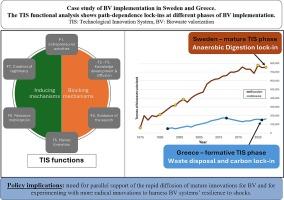Path-dependencies in the transition to sustainable biowaste valorization: Lessons from a socio-technical analysis of Sweden and Greece
IF 7.1
2区 环境科学与生态学
Q1 ENGINEERING, ENVIRONMENTAL
引用次数: 0
Abstract
Achieving sustainable biowaste management is a key challenge for cities worldwide. In this context, biowaste valorization is an indispensable option for managing unavoidable biowaste and reducing the associated methane emissions. Several innovations that enable biowaste valorization are technologically mature. However, their implementation is still limited in most cities around the world. Therefore, it is essential to better understand the different pathways towards implementing biowaste valorization. This paper presents a case-study of two countries at different phases in their transition to biowaste valorization: Sweden as a case at a mature phase and Greece as a case at a formative phase. We apply the Technological Innovation Systems framework to investigate how innovation systems for biowaste valorization develop and associated path-dependencies. Our findings show that various path-dependence lock-ins can occur at different transition phases. Our empirical insights suggest that a focus on the diffusion of certain mature innovations can support the growth of biowaste valorization systems. However, it can also lead to path-dependence lock-ins that influence the systems’ resilience to shocks. We thus recommend decision-makers to pursue balance between the rapid diffusion of mature innovations for biowaste valorization and parallel support for experimenting with more radical innovations to harness the systems’ resilience to shocks.

向可持续生物废物价值化过渡的路径依赖:从瑞典和希腊的社会技术分析中汲取的经验教训
实现可持续的生物垃圾管理是全球城市面临的一项关键挑战。在这种情况下,生物废弃物价值化是管理不可避免的生物废弃物和减少相关甲烷排放的一个不可或缺的选择。一些实现生物废物价值化的创新技术在技术上已经成熟。然而,这些技术在全球大多数城市的实施仍然有限。因此,有必要更好地了解实现生物废物价值化的不同途径。本文介绍了两个国家在向生物废物价值化过渡的不同阶段的案例研究:瑞典处于成熟阶段,希腊处于形成阶段。我们运用技术创新系统框架来研究生物废物价值化创新系统的发展过程和相关路径依赖。我们的研究结果表明,在不同的过渡阶段会出现各种路径依赖锁定现象。我们的经验见解表明,关注某些成熟创新的推广可以支持生物垃圾处理系统的发展。然而,这也可能导致路径依赖锁定,影响系统抵御冲击的能力。因此,我们建议决策者在快速推广成熟的生物废物价值化创新与同时支持尝试更激进的创新之间寻求平衡,以利用系统的抗冲击能力。
本文章由计算机程序翻译,如有差异,请以英文原文为准。
求助全文
约1分钟内获得全文
求助全文
来源期刊

Waste management
环境科学-工程:环境
CiteScore
15.60
自引率
6.20%
发文量
492
审稿时长
39 days
期刊介绍:
Waste Management is devoted to the presentation and discussion of information on solid wastes,it covers the entire lifecycle of solid. wastes.
Scope:
Addresses solid wastes in both industrialized and economically developing countries
Covers various types of solid wastes, including:
Municipal (e.g., residential, institutional, commercial, light industrial)
Agricultural
Special (e.g., C and D, healthcare, household hazardous wastes, sewage sludge)
 求助内容:
求助内容: 应助结果提醒方式:
应助结果提醒方式:


